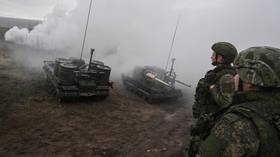‘It’s so violent’: Scientists propose revolutionary new kind of engine for space travel, there’s just one small catch (VIDEOS)
Researchers at the University of Washington have announced early findings on a potentially revolutionary new type of ‘rotating detonation engine’ which could help produce cheaper, lighter spacecraft. There’s just one small catch.
While the research is only in its infancy, the fuel-efficient rocket would, theoretically at least, be easier and cheaper to build than current space-faring rockets, paving the way for more space travel at a lower cost to the environment. For instance, it currently takes about 3.5 million pounds of fuel to send NASA’s space shuttles into space.
Also on rt.com Not magic, science! Researchers develop system to produce electricity out of thin airA conventional rocket engine burns propellant and forces it out the back using a vast array of machinery and control nozzles to create thrust and launch the rocket skyward, without any unforeseen detours.
In the rotating detonation engine, however, the shockwave does all the work, without the need for complicated machinery in the engine to direct the thrust, after which a number of secondary combustion pulses follow to launch the beast skyward. At least that’s the theory.
The problem is, for the time being anyway, the engine is too unpredictable to use.
“It’s made of concentric cylinders. Propellant flows in the gap between the cylinders, and, after ignition, the rapid heat release forms a shock wave, a strong pulse of gas with significantly higher pressure and temperature that is moving faster than the speed of sound,” said lead author James Koch, a UW doctoral student in aeronautics and astronautics.
“The downside of that is that these detonations have a mind of their own. Once you detonate something, it just goes. It’s so violent.”
Koch and his team conducted a series of 0.5-second experiments captured using high-speed cameras at 240,000 frames per second to show exactly what happens when such engines fire, so they could then begin crunching the numbers and figure out how to replicate the power and efficiency minus the chaos.
The researchers have since developed a mathematical model which they are poring over to begin the process of developing a functioning prototype engine which wouldn't plaster a crew against the rear of the spaceship.
“Now I can take what I’ve done here and make it quantitative. From there we can talk about how to make a better engine,” Koch concludes.
Also on rt.com Space bagel: Russia to fly donut-shaped spaceship to edge of solar systemLike this story? Share it with a friend!
















